University ERP Implementation: Benefits, Challenges, and Strategies
VerifiedAdded on 2020/03/04
|22
|5629
|219
Report
AI Summary
This report provides a comprehensive analysis of Enterprise Resource Planning (ERP) implementation, exploring its characteristics, advantages, and the factors influencing benefit realization. It delves into the ERP implementation process within organizations, highlighting the challenges and barriers to realizing expected benefits, such as the role of customization and the importance of aligning organizational processes. The report also examines the impact of ERP systems on various business functions, including financial data integration, customer order management, and manufacturing processes. It further discusses the contextual analysis of ERP frameworks in educational institutes, providing insights into successful ERP implementations. The report also covers the difference between actual and expected ERP usage benefits, along with contextual analysis of ERP frameworks, and concludes with the challenges and future trends related to ERP systems and their implementation. The report leverages exploratory and investigative research methods, including case studies, to understand the topic thoroughly.
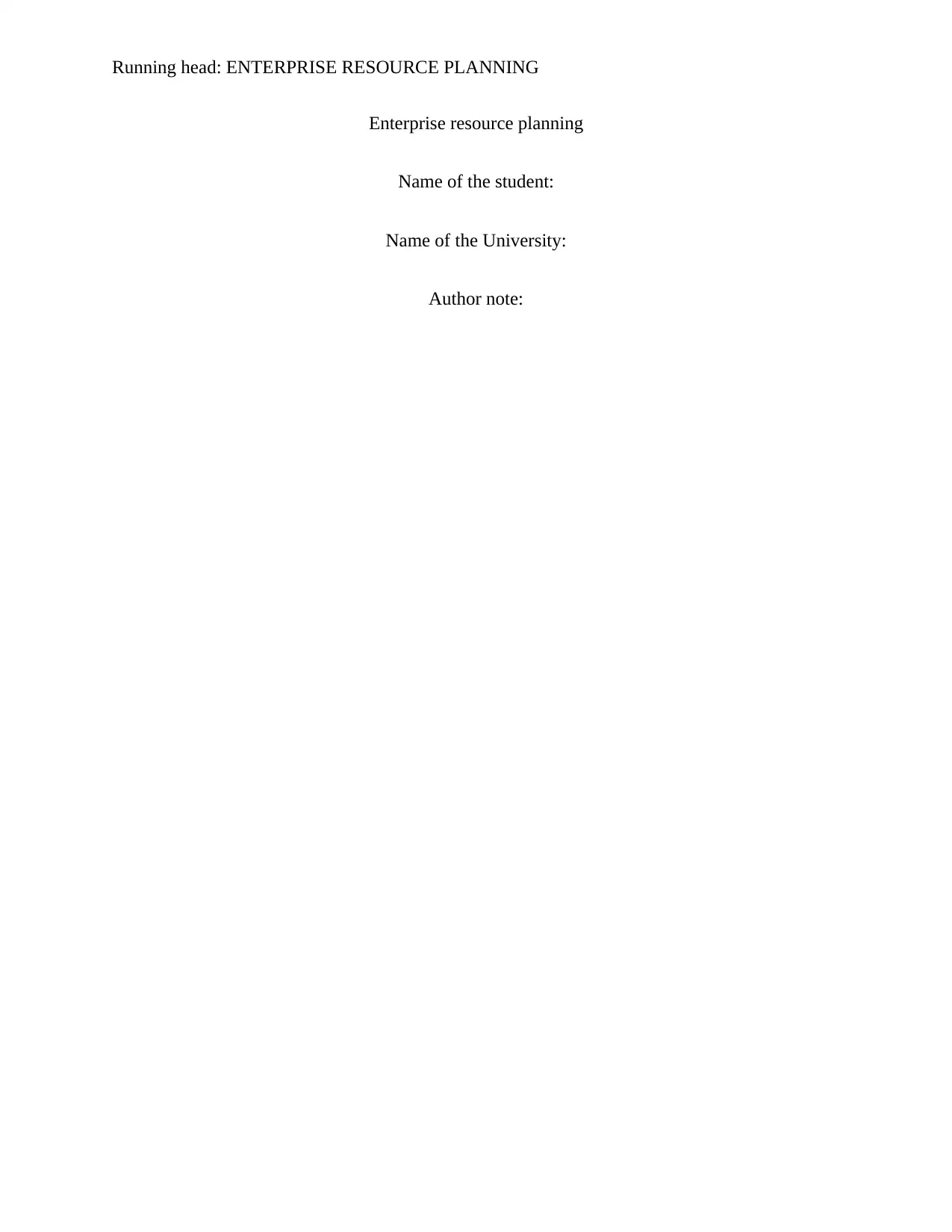
Running head: ENTERPRISE RESOURCE PLANNING
Enterprise resource planning
Name of the student:
Name of the University:
Author note:
Enterprise resource planning
Name of the student:
Name of the University:
Author note:
Paraphrase This Document
Need a fresh take? Get an instant paraphrase of this document with our AI Paraphraser
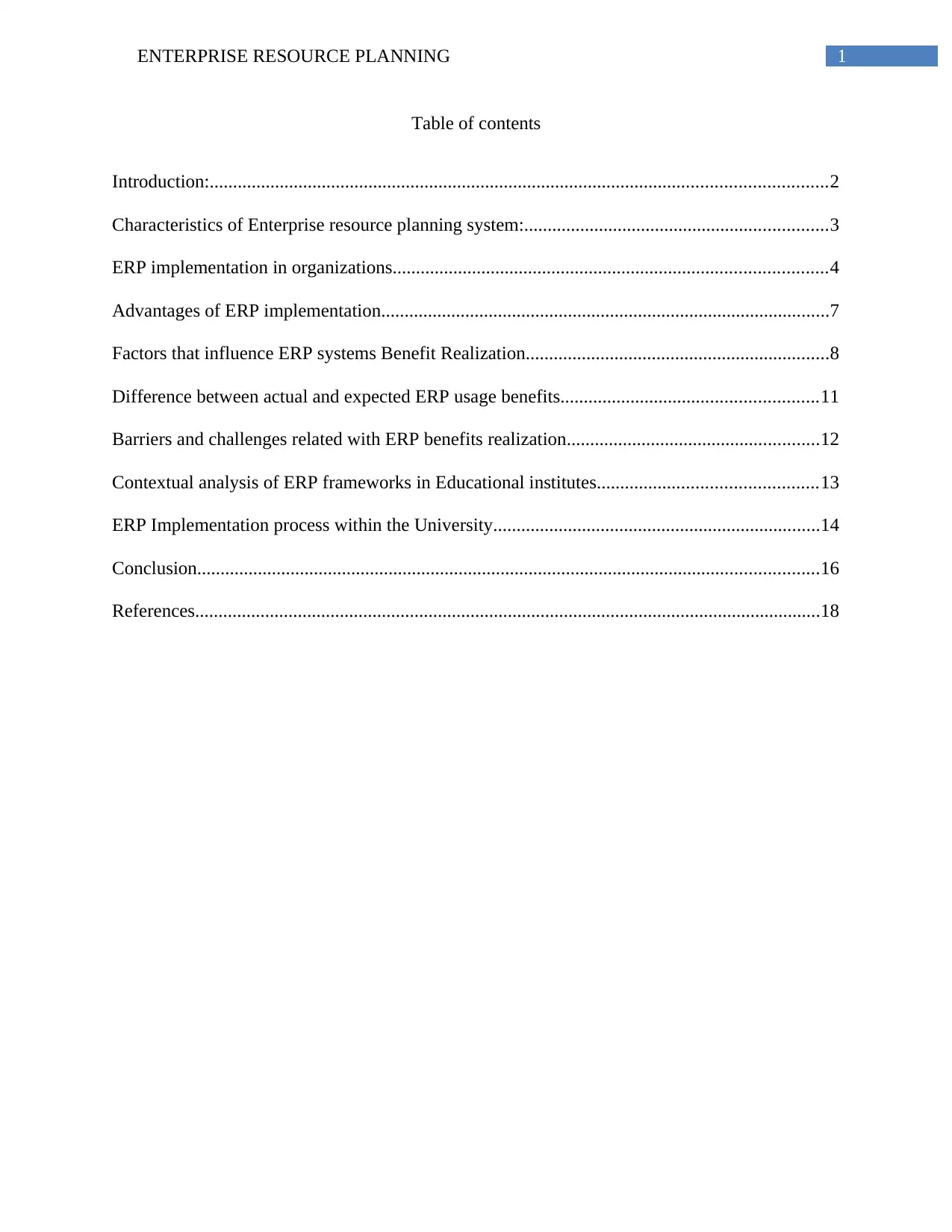
1ENTERPRISE RESOURCE PLANNING
Table of contents
Introduction:....................................................................................................................................2
Characteristics of Enterprise resource planning system:.................................................................3
ERP implementation in organizations.............................................................................................4
Advantages of ERP implementation................................................................................................7
Factors that influence ERP systems Benefit Realization.................................................................8
Difference between actual and expected ERP usage benefits.......................................................11
Barriers and challenges related with ERP benefits realization......................................................12
Contextual analysis of ERP frameworks in Educational institutes...............................................13
ERP Implementation process within the University......................................................................14
Conclusion.....................................................................................................................................16
References......................................................................................................................................18
Table of contents
Introduction:....................................................................................................................................2
Characteristics of Enterprise resource planning system:.................................................................3
ERP implementation in organizations.............................................................................................4
Advantages of ERP implementation................................................................................................7
Factors that influence ERP systems Benefit Realization.................................................................8
Difference between actual and expected ERP usage benefits.......................................................11
Barriers and challenges related with ERP benefits realization......................................................12
Contextual analysis of ERP frameworks in Educational institutes...............................................13
ERP Implementation process within the University......................................................................14
Conclusion.....................................................................................................................................16
References......................................................................................................................................18
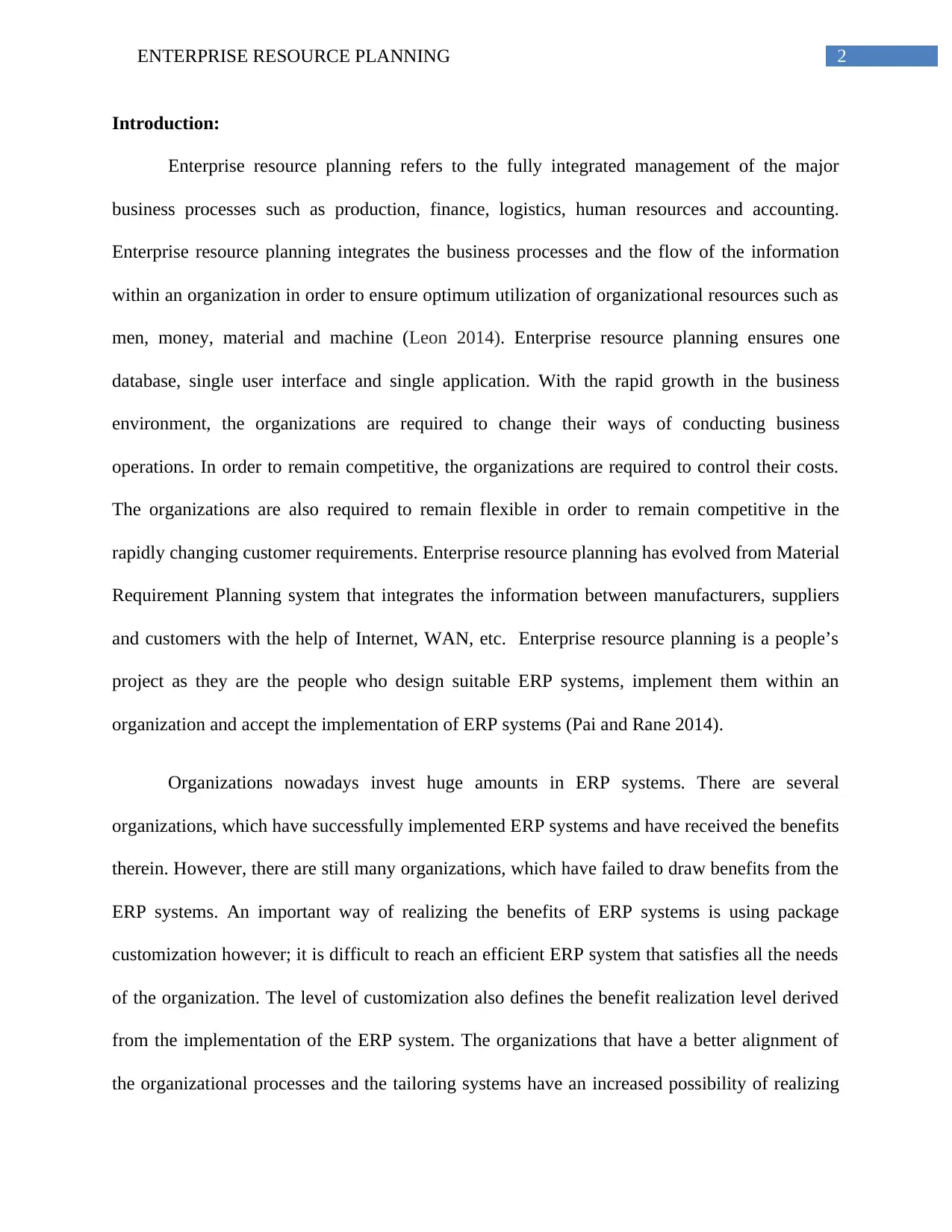
2ENTERPRISE RESOURCE PLANNING
Introduction:
Enterprise resource planning refers to the fully integrated management of the major
business processes such as production, finance, logistics, human resources and accounting.
Enterprise resource planning integrates the business processes and the flow of the information
within an organization in order to ensure optimum utilization of organizational resources such as
men, money, material and machine (Leon 2014). Enterprise resource planning ensures one
database, single user interface and single application. With the rapid growth in the business
environment, the organizations are required to change their ways of conducting business
operations. In order to remain competitive, the organizations are required to control their costs.
The organizations are also required to remain flexible in order to remain competitive in the
rapidly changing customer requirements. Enterprise resource planning has evolved from Material
Requirement Planning system that integrates the information between manufacturers, suppliers
and customers with the help of Internet, WAN, etc. Enterprise resource planning is a people’s
project as they are the people who design suitable ERP systems, implement them within an
organization and accept the implementation of ERP systems (Pai and Rane 2014).
Organizations nowadays invest huge amounts in ERP systems. There are several
organizations, which have successfully implemented ERP systems and have received the benefits
therein. However, there are still many organizations, which have failed to draw benefits from the
ERP systems. An important way of realizing the benefits of ERP systems is using package
customization however; it is difficult to reach an efficient ERP system that satisfies all the needs
of the organization. The level of customization also defines the benefit realization level derived
from the implementation of the ERP system. The organizations that have a better alignment of
the organizational processes and the tailoring systems have an increased possibility of realizing
Introduction:
Enterprise resource planning refers to the fully integrated management of the major
business processes such as production, finance, logistics, human resources and accounting.
Enterprise resource planning integrates the business processes and the flow of the information
within an organization in order to ensure optimum utilization of organizational resources such as
men, money, material and machine (Leon 2014). Enterprise resource planning ensures one
database, single user interface and single application. With the rapid growth in the business
environment, the organizations are required to change their ways of conducting business
operations. In order to remain competitive, the organizations are required to control their costs.
The organizations are also required to remain flexible in order to remain competitive in the
rapidly changing customer requirements. Enterprise resource planning has evolved from Material
Requirement Planning system that integrates the information between manufacturers, suppliers
and customers with the help of Internet, WAN, etc. Enterprise resource planning is a people’s
project as they are the people who design suitable ERP systems, implement them within an
organization and accept the implementation of ERP systems (Pai and Rane 2014).
Organizations nowadays invest huge amounts in ERP systems. There are several
organizations, which have successfully implemented ERP systems and have received the benefits
therein. However, there are still many organizations, which have failed to draw benefits from the
ERP systems. An important way of realizing the benefits of ERP systems is using package
customization however; it is difficult to reach an efficient ERP system that satisfies all the needs
of the organization. The level of customization also defines the benefit realization level derived
from the implementation of the ERP system. The organizations that have a better alignment of
the organizational processes and the tailoring systems have an increased possibility of realizing
⊘ This is a preview!⊘
Do you want full access?
Subscribe today to unlock all pages.

Trusted by 1+ million students worldwide
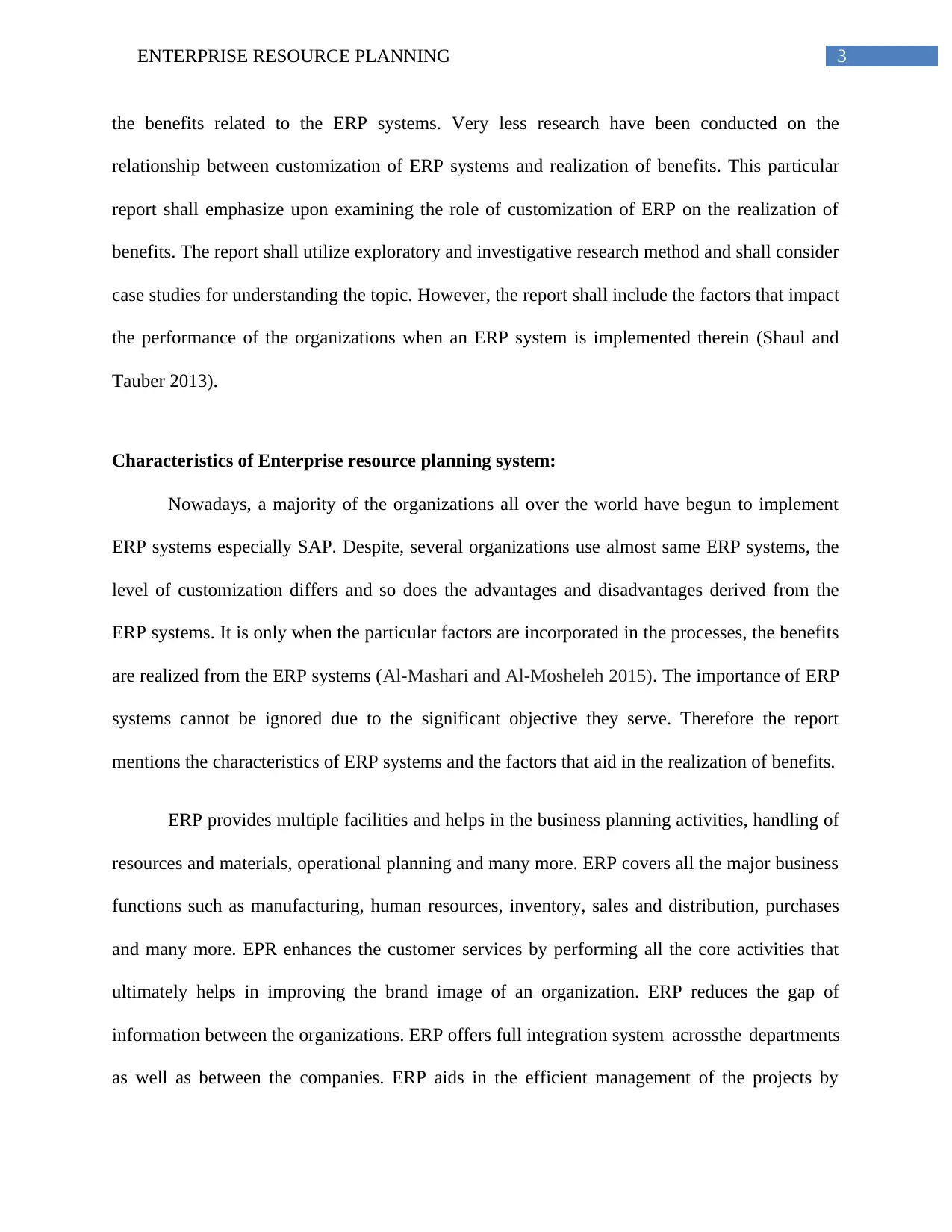
3ENTERPRISE RESOURCE PLANNING
the benefits related to the ERP systems. Very less research have been conducted on the
relationship between customization of ERP systems and realization of benefits. This particular
report shall emphasize upon examining the role of customization of ERP on the realization of
benefits. The report shall utilize exploratory and investigative research method and shall consider
case studies for understanding the topic. However, the report shall include the factors that impact
the performance of the organizations when an ERP system is implemented therein (Shaul and
Tauber 2013).
Characteristics of Enterprise resource planning system:
Nowadays, a majority of the organizations all over the world have begun to implement
ERP systems especially SAP. Despite, several organizations use almost same ERP systems, the
level of customization differs and so does the advantages and disadvantages derived from the
ERP systems. It is only when the particular factors are incorporated in the processes, the benefits
are realized from the ERP systems (Al-Mashari and Al-Mosheleh 2015). The importance of ERP
systems cannot be ignored due to the significant objective they serve. Therefore the report
mentions the characteristics of ERP systems and the factors that aid in the realization of benefits.
ERP provides multiple facilities and helps in the business planning activities, handling of
resources and materials, operational planning and many more. ERP covers all the major business
functions such as manufacturing, human resources, inventory, sales and distribution, purchases
and many more. EPR enhances the customer services by performing all the core activities that
ultimately helps in improving the brand image of an organization. ERP reduces the gap of
information between the organizations. ERP offers full integration system acrossthe departments
as well as between the companies. ERP aids in the efficient management of the projects by
the benefits related to the ERP systems. Very less research have been conducted on the
relationship between customization of ERP systems and realization of benefits. This particular
report shall emphasize upon examining the role of customization of ERP on the realization of
benefits. The report shall utilize exploratory and investigative research method and shall consider
case studies for understanding the topic. However, the report shall include the factors that impact
the performance of the organizations when an ERP system is implemented therein (Shaul and
Tauber 2013).
Characteristics of Enterprise resource planning system:
Nowadays, a majority of the organizations all over the world have begun to implement
ERP systems especially SAP. Despite, several organizations use almost same ERP systems, the
level of customization differs and so does the advantages and disadvantages derived from the
ERP systems. It is only when the particular factors are incorporated in the processes, the benefits
are realized from the ERP systems (Al-Mashari and Al-Mosheleh 2015). The importance of ERP
systems cannot be ignored due to the significant objective they serve. Therefore the report
mentions the characteristics of ERP systems and the factors that aid in the realization of benefits.
ERP provides multiple facilities and helps in the business planning activities, handling of
resources and materials, operational planning and many more. ERP covers all the major business
functions such as manufacturing, human resources, inventory, sales and distribution, purchases
and many more. EPR enhances the customer services by performing all the core activities that
ultimately helps in improving the brand image of an organization. ERP reduces the gap of
information between the organizations. ERP offers full integration system acrossthe departments
as well as between the companies. ERP aids in the efficient management of the projects by
Paraphrase This Document
Need a fresh take? Get an instant paraphrase of this document with our AI Paraphraser
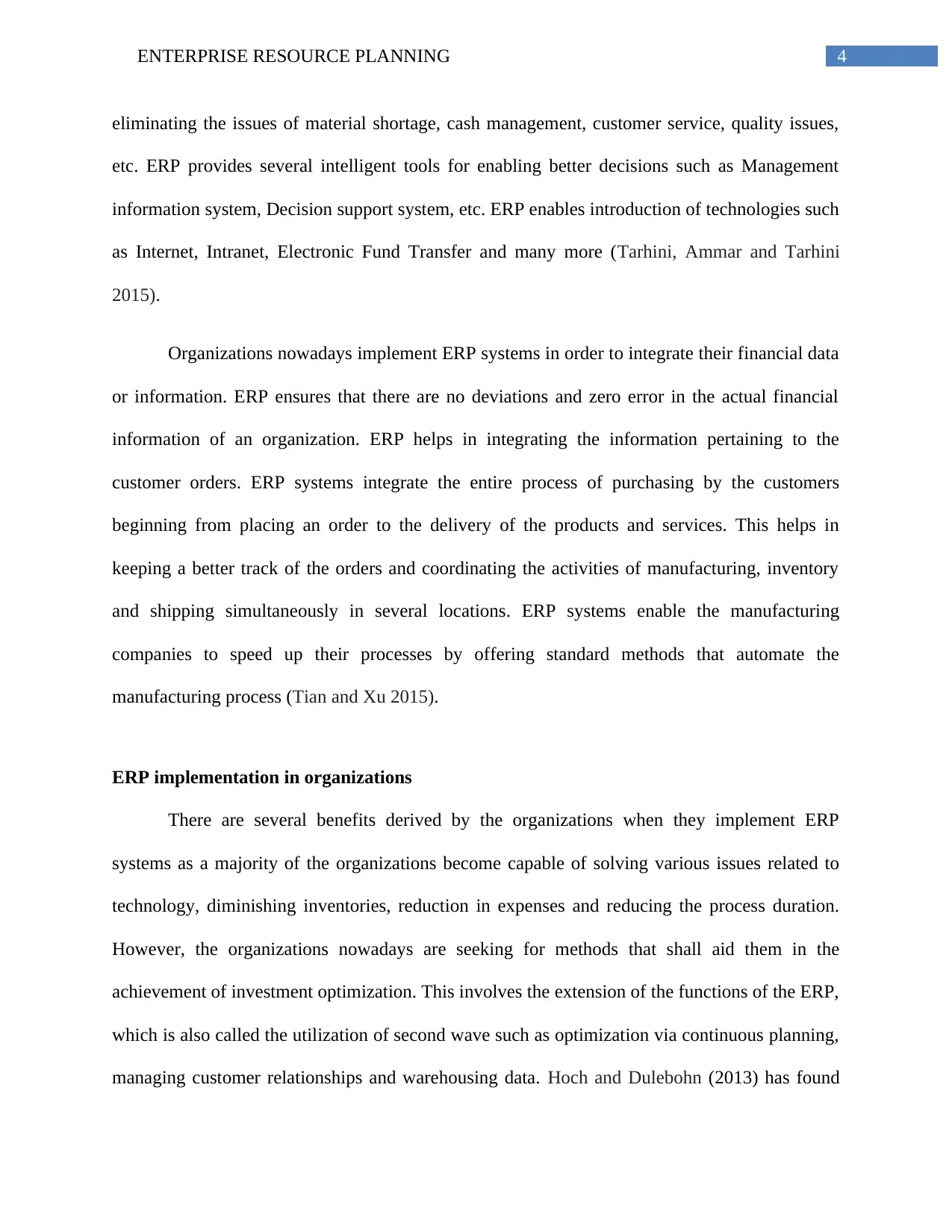
4ENTERPRISE RESOURCE PLANNING
eliminating the issues of material shortage, cash management, customer service, quality issues,
etc. ERP provides several intelligent tools for enabling better decisions such as Management
information system, Decision support system, etc. ERP enables introduction of technologies such
as Internet, Intranet, Electronic Fund Transfer and many more (Tarhini, Ammar and Tarhini
2015).
Organizations nowadays implement ERP systems in order to integrate their financial data
or information. ERP ensures that there are no deviations and zero error in the actual financial
information of an organization. ERP helps in integrating the information pertaining to the
customer orders. ERP systems integrate the entire process of purchasing by the customers
beginning from placing an order to the delivery of the products and services. This helps in
keeping a better track of the orders and coordinating the activities of manufacturing, inventory
and shipping simultaneously in several locations. ERP systems enable the manufacturing
companies to speed up their processes by offering standard methods that automate the
manufacturing process (Tian and Xu 2015).
ERP implementation in organizations
There are several benefits derived by the organizations when they implement ERP
systems as a majority of the organizations become capable of solving various issues related to
technology, diminishing inventories, reduction in expenses and reducing the process duration.
However, the organizations nowadays are seeking for methods that shall aid them in the
achievement of investment optimization. This involves the extension of the functions of the ERP,
which is also called the utilization of second wave such as optimization via continuous planning,
managing customer relationships and warehousing data. Hoch and Dulebohn (2013) has found
eliminating the issues of material shortage, cash management, customer service, quality issues,
etc. ERP provides several intelligent tools for enabling better decisions such as Management
information system, Decision support system, etc. ERP enables introduction of technologies such
as Internet, Intranet, Electronic Fund Transfer and many more (Tarhini, Ammar and Tarhini
2015).
Organizations nowadays implement ERP systems in order to integrate their financial data
or information. ERP ensures that there are no deviations and zero error in the actual financial
information of an organization. ERP helps in integrating the information pertaining to the
customer orders. ERP systems integrate the entire process of purchasing by the customers
beginning from placing an order to the delivery of the products and services. This helps in
keeping a better track of the orders and coordinating the activities of manufacturing, inventory
and shipping simultaneously in several locations. ERP systems enable the manufacturing
companies to speed up their processes by offering standard methods that automate the
manufacturing process (Tian and Xu 2015).
ERP implementation in organizations
There are several benefits derived by the organizations when they implement ERP
systems as a majority of the organizations become capable of solving various issues related to
technology, diminishing inventories, reduction in expenses and reducing the process duration.
However, the organizations nowadays are seeking for methods that shall aid them in the
achievement of investment optimization. This involves the extension of the functions of the ERP,
which is also called the utilization of second wave such as optimization via continuous planning,
managing customer relationships and warehousing data. Hoch and Dulebohn (2013) has found
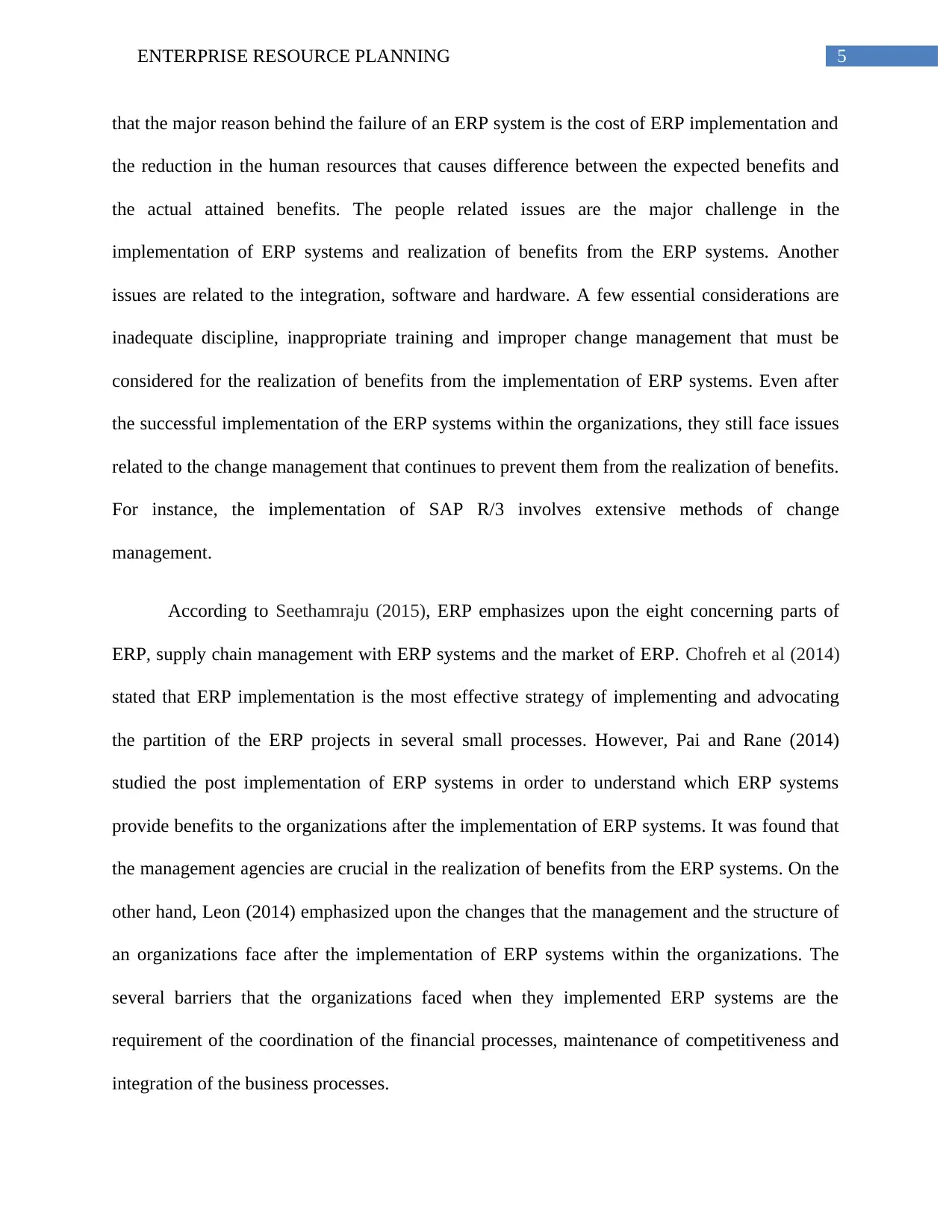
5ENTERPRISE RESOURCE PLANNING
that the major reason behind the failure of an ERP system is the cost of ERP implementation and
the reduction in the human resources that causes difference between the expected benefits and
the actual attained benefits. The people related issues are the major challenge in the
implementation of ERP systems and realization of benefits from the ERP systems. Another
issues are related to the integration, software and hardware. A few essential considerations are
inadequate discipline, inappropriate training and improper change management that must be
considered for the realization of benefits from the implementation of ERP systems. Even after
the successful implementation of the ERP systems within the organizations, they still face issues
related to the change management that continues to prevent them from the realization of benefits.
For instance, the implementation of SAP R/3 involves extensive methods of change
management.
According to Seethamraju (2015), ERP emphasizes upon the eight concerning parts of
ERP, supply chain management with ERP systems and the market of ERP. Chofreh et al (2014)
stated that ERP implementation is the most effective strategy of implementing and advocating
the partition of the ERP projects in several small processes. However, Pai and Rane (2014)
studied the post implementation of ERP systems in order to understand which ERP systems
provide benefits to the organizations after the implementation of ERP systems. It was found that
the management agencies are crucial in the realization of benefits from the ERP systems. On the
other hand, Leon (2014) emphasized upon the changes that the management and the structure of
an organizations face after the implementation of ERP systems within the organizations. The
several barriers that the organizations faced when they implemented ERP systems are the
requirement of the coordination of the financial processes, maintenance of competitiveness and
integration of the business processes.
that the major reason behind the failure of an ERP system is the cost of ERP implementation and
the reduction in the human resources that causes difference between the expected benefits and
the actual attained benefits. The people related issues are the major challenge in the
implementation of ERP systems and realization of benefits from the ERP systems. Another
issues are related to the integration, software and hardware. A few essential considerations are
inadequate discipline, inappropriate training and improper change management that must be
considered for the realization of benefits from the implementation of ERP systems. Even after
the successful implementation of the ERP systems within the organizations, they still face issues
related to the change management that continues to prevent them from the realization of benefits.
For instance, the implementation of SAP R/3 involves extensive methods of change
management.
According to Seethamraju (2015), ERP emphasizes upon the eight concerning parts of
ERP, supply chain management with ERP systems and the market of ERP. Chofreh et al (2014)
stated that ERP implementation is the most effective strategy of implementing and advocating
the partition of the ERP projects in several small processes. However, Pai and Rane (2014)
studied the post implementation of ERP systems in order to understand which ERP systems
provide benefits to the organizations after the implementation of ERP systems. It was found that
the management agencies are crucial in the realization of benefits from the ERP systems. On the
other hand, Leon (2014) emphasized upon the changes that the management and the structure of
an organizations face after the implementation of ERP systems within the organizations. The
several barriers that the organizations faced when they implemented ERP systems are the
requirement of the coordination of the financial processes, maintenance of competitiveness and
integration of the business processes.
⊘ This is a preview!⊘
Do you want full access?
Subscribe today to unlock all pages.

Trusted by 1+ million students worldwide
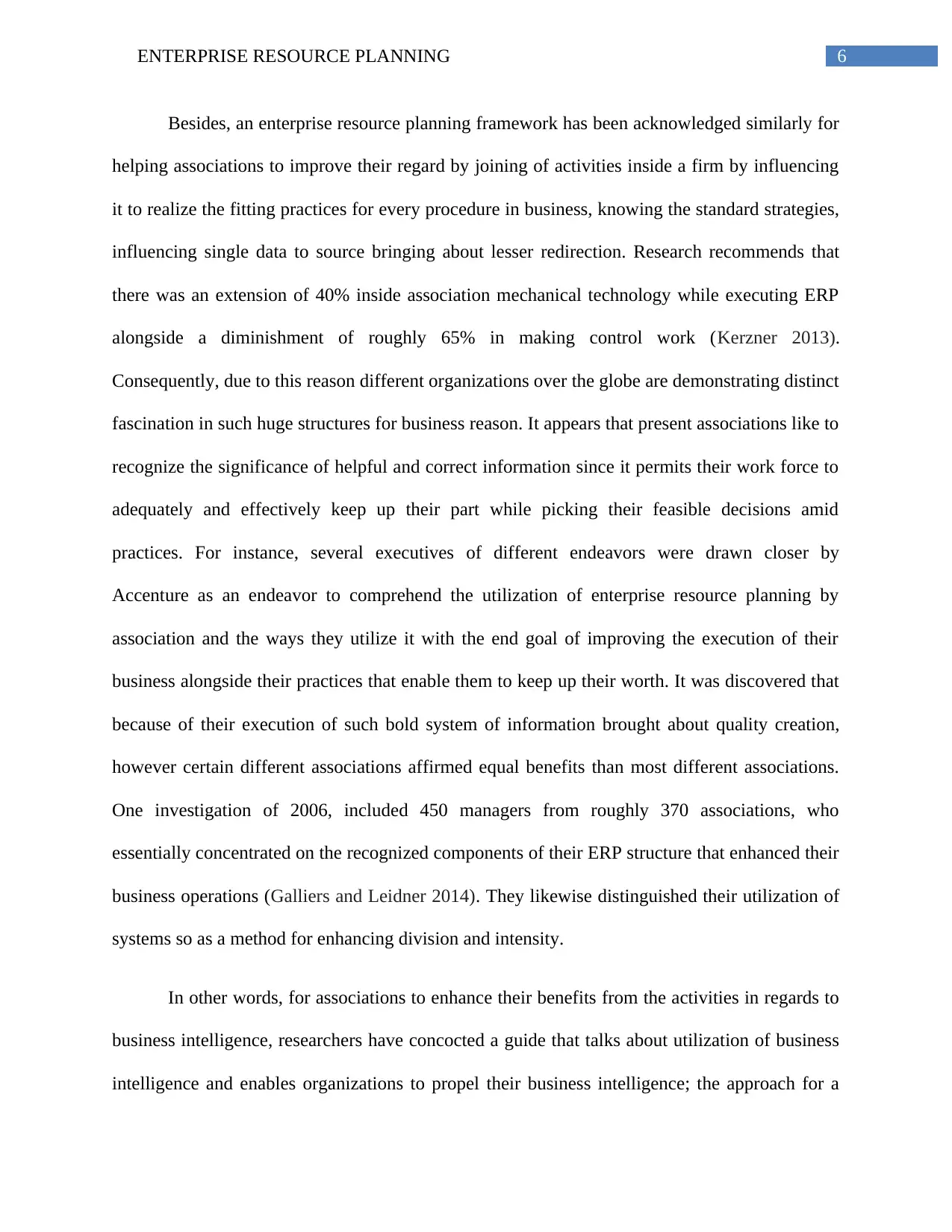
6ENTERPRISE RESOURCE PLANNING
Besides, an enterprise resource planning framework has been acknowledged similarly for
helping associations to improve their regard by joining of activities inside a firm by influencing
it to realize the fitting practices for every procedure in business, knowing the standard strategies,
influencing single data to source bringing about lesser redirection. Research recommends that
there was an extension of 40% inside association mechanical technology while executing ERP
alongside a diminishment of roughly 65% in making control work (Kerzner 2013).
Consequently, due to this reason different organizations over the globe are demonstrating distinct
fascination in such huge structures for business reason. It appears that present associations like to
recognize the significance of helpful and correct information since it permits their work force to
adequately and effectively keep up their part while picking their feasible decisions amid
practices. For instance, several executives of different endeavors were drawn closer by
Accenture as an endeavor to comprehend the utilization of enterprise resource planning by
association and the ways they utilize it with the end goal of improving the execution of their
business alongside their practices that enable them to keep up their worth. It was discovered that
because of their execution of such bold system of information brought about quality creation,
however certain different associations affirmed equal benefits than most different associations.
One investigation of 2006, included 450 managers from roughly 370 associations, who
essentially concentrated on the recognized components of their ERP structure that enhanced their
business operations (Galliers and Leidner 2014). They likewise distinguished their utilization of
systems so as a method for enhancing division and intensity.
In other words, for associations to enhance their benefits from the activities in regards to
business intelligence, researchers have concocted a guide that talks about utilization of business
intelligence and enables organizations to propel their business intelligence; the approach for a
Besides, an enterprise resource planning framework has been acknowledged similarly for
helping associations to improve their regard by joining of activities inside a firm by influencing
it to realize the fitting practices for every procedure in business, knowing the standard strategies,
influencing single data to source bringing about lesser redirection. Research recommends that
there was an extension of 40% inside association mechanical technology while executing ERP
alongside a diminishment of roughly 65% in making control work (Kerzner 2013).
Consequently, due to this reason different organizations over the globe are demonstrating distinct
fascination in such huge structures for business reason. It appears that present associations like to
recognize the significance of helpful and correct information since it permits their work force to
adequately and effectively keep up their part while picking their feasible decisions amid
practices. For instance, several executives of different endeavors were drawn closer by
Accenture as an endeavor to comprehend the utilization of enterprise resource planning by
association and the ways they utilize it with the end goal of improving the execution of their
business alongside their practices that enable them to keep up their worth. It was discovered that
because of their execution of such bold system of information brought about quality creation,
however certain different associations affirmed equal benefits than most different associations.
One investigation of 2006, included 450 managers from roughly 370 associations, who
essentially concentrated on the recognized components of their ERP structure that enhanced their
business operations (Galliers and Leidner 2014). They likewise distinguished their utilization of
systems so as a method for enhancing division and intensity.
In other words, for associations to enhance their benefits from the activities in regards to
business intelligence, researchers have concocted a guide that talks about utilization of business
intelligence and enables organizations to propel their business intelligence; the approach for a
Paraphrase This Document
Need a fresh take? Get an instant paraphrase of this document with our AI Paraphraser
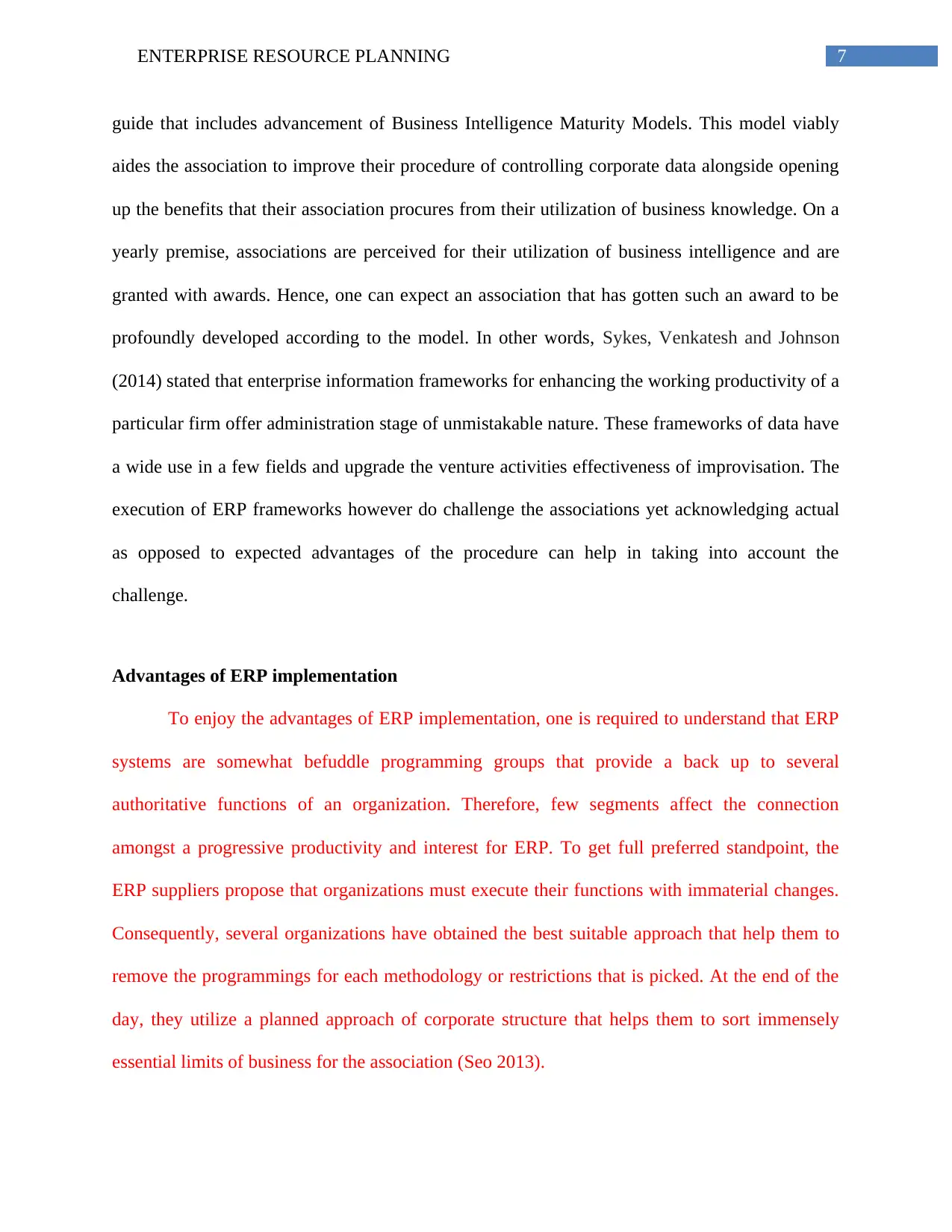
7ENTERPRISE RESOURCE PLANNING
guide that includes advancement of Business Intelligence Maturity Models. This model viably
aides the association to improve their procedure of controlling corporate data alongside opening
up the benefits that their association procures from their utilization of business knowledge. On a
yearly premise, associations are perceived for their utilization of business intelligence and are
granted with awards. Hence, one can expect an association that has gotten such an award to be
profoundly developed according to the model. In other words, Sykes, Venkatesh and Johnson
(2014) stated that enterprise information frameworks for enhancing the working productivity of a
particular firm offer administration stage of unmistakable nature. These frameworks of data have
a wide use in a few fields and upgrade the venture activities effectiveness of improvisation. The
execution of ERP frameworks however do challenge the associations yet acknowledging actual
as opposed to expected advantages of the procedure can help in taking into account the
challenge.
Advantages of ERP implementation
To enjoy the advantages of ERP implementation, one is required to understand that ERP
systems are somewhat befuddle programming groups that provide a back up to several
authoritative functions of an organization. Therefore, few segments affect the connection
amongst a progressive productivity and interest for ERP. To get full preferred standpoint, the
ERP suppliers propose that organizations must execute their functions with immaterial changes.
Consequently, several organizations have obtained the best suitable approach that help them to
remove the programmings for each methodology or restrictions that is picked. At the end of the
day, they utilize a planned approach of corporate structure that helps them to sort immensely
essential limits of business for the association (Seo 2013).
guide that includes advancement of Business Intelligence Maturity Models. This model viably
aides the association to improve their procedure of controlling corporate data alongside opening
up the benefits that their association procures from their utilization of business knowledge. On a
yearly premise, associations are perceived for their utilization of business intelligence and are
granted with awards. Hence, one can expect an association that has gotten such an award to be
profoundly developed according to the model. In other words, Sykes, Venkatesh and Johnson
(2014) stated that enterprise information frameworks for enhancing the working productivity of a
particular firm offer administration stage of unmistakable nature. These frameworks of data have
a wide use in a few fields and upgrade the venture activities effectiveness of improvisation. The
execution of ERP frameworks however do challenge the associations yet acknowledging actual
as opposed to expected advantages of the procedure can help in taking into account the
challenge.
Advantages of ERP implementation
To enjoy the advantages of ERP implementation, one is required to understand that ERP
systems are somewhat befuddle programming groups that provide a back up to several
authoritative functions of an organization. Therefore, few segments affect the connection
amongst a progressive productivity and interest for ERP. To get full preferred standpoint, the
ERP suppliers propose that organizations must execute their functions with immaterial changes.
Consequently, several organizations have obtained the best suitable approach that help them to
remove the programmings for each methodology or restrictions that is picked. At the end of the
day, they utilize a planned approach of corporate structure that helps them to sort immensely
essential limits of business for the association (Seo 2013).
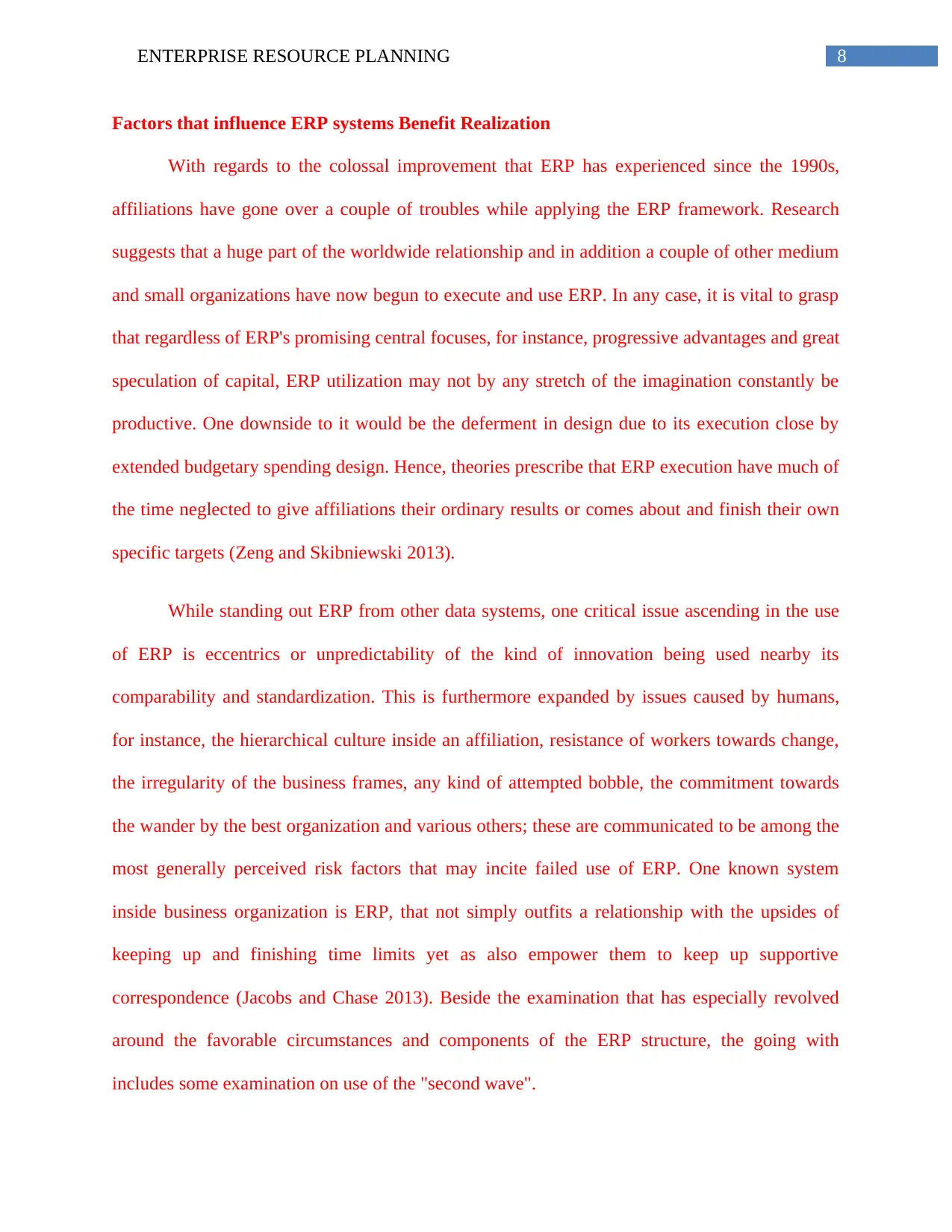
8ENTERPRISE RESOURCE PLANNING
Factors that influence ERP systems Benefit Realization
With regards to the colossal improvement that ERP has experienced since the 1990s,
affiliations have gone over a couple of troubles while applying the ERP framework. Research
suggests that a huge part of the worldwide relationship and in addition a couple of other medium
and small organizations have now begun to execute and use ERP. In any case, it is vital to grasp
that regardless of ERP's promising central focuses, for instance, progressive advantages and great
speculation of capital, ERP utilization may not by any stretch of the imagination constantly be
productive. One downside to it would be the deferment in design due to its execution close by
extended budgetary spending design. Hence, theories prescribe that ERP execution have much of
the time neglected to give affiliations their ordinary results or comes about and finish their own
specific targets (Zeng and Skibniewski 2013).
While standing out ERP from other data systems, one critical issue ascending in the use
of ERP is eccentrics or unpredictability of the kind of innovation being used nearby its
comparability and standardization. This is furthermore expanded by issues caused by humans,
for instance, the hierarchical culture inside an affiliation, resistance of workers towards change,
the irregularity of the business frames, any kind of attempted bobble, the commitment towards
the wander by the best organization and various others; these are communicated to be among the
most generally perceived risk factors that may incite failed use of ERP. One known system
inside business organization is ERP, that not simply outfits a relationship with the upsides of
keeping up and finishing time limits yet as also empower them to keep up supportive
correspondence (Jacobs and Chase 2013). Beside the examination that has especially revolved
around the favorable circumstances and components of the ERP structure, the going with
includes some examination on use of the "second wave".
Factors that influence ERP systems Benefit Realization
With regards to the colossal improvement that ERP has experienced since the 1990s,
affiliations have gone over a couple of troubles while applying the ERP framework. Research
suggests that a huge part of the worldwide relationship and in addition a couple of other medium
and small organizations have now begun to execute and use ERP. In any case, it is vital to grasp
that regardless of ERP's promising central focuses, for instance, progressive advantages and great
speculation of capital, ERP utilization may not by any stretch of the imagination constantly be
productive. One downside to it would be the deferment in design due to its execution close by
extended budgetary spending design. Hence, theories prescribe that ERP execution have much of
the time neglected to give affiliations their ordinary results or comes about and finish their own
specific targets (Zeng and Skibniewski 2013).
While standing out ERP from other data systems, one critical issue ascending in the use
of ERP is eccentrics or unpredictability of the kind of innovation being used nearby its
comparability and standardization. This is furthermore expanded by issues caused by humans,
for instance, the hierarchical culture inside an affiliation, resistance of workers towards change,
the irregularity of the business frames, any kind of attempted bobble, the commitment towards
the wander by the best organization and various others; these are communicated to be among the
most generally perceived risk factors that may incite failed use of ERP. One known system
inside business organization is ERP, that not simply outfits a relationship with the upsides of
keeping up and finishing time limits yet as also empower them to keep up supportive
correspondence (Jacobs and Chase 2013). Beside the examination that has especially revolved
around the favorable circumstances and components of the ERP structure, the going with
includes some examination on use of the "second wave".
⊘ This is a preview!⊘
Do you want full access?
Subscribe today to unlock all pages.

Trusted by 1+ million students worldwide
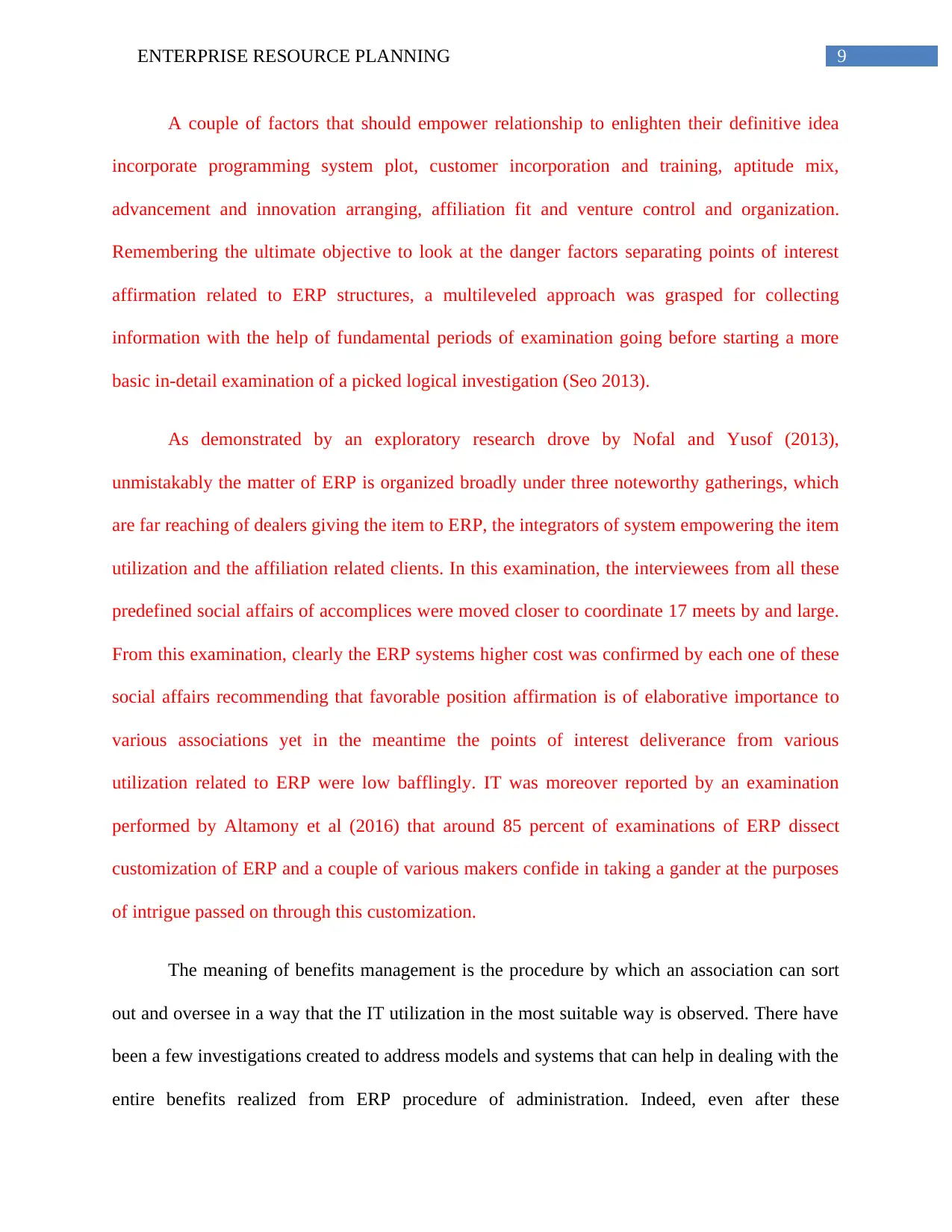
9ENTERPRISE RESOURCE PLANNING
A couple of factors that should empower relationship to enlighten their definitive idea
incorporate programming system plot, customer incorporation and training, aptitude mix,
advancement and innovation arranging, affiliation fit and venture control and organization.
Remembering the ultimate objective to look at the danger factors separating points of interest
affirmation related to ERP structures, a multileveled approach was grasped for collecting
information with the help of fundamental periods of examination going before starting a more
basic in-detail examination of a picked logical investigation (Seo 2013).
As demonstrated by an exploratory research drove by Nofal and Yusof (2013),
unmistakably the matter of ERP is organized broadly under three noteworthy gatherings, which
are far reaching of dealers giving the item to ERP, the integrators of system empowering the item
utilization and the affiliation related clients. In this examination, the interviewees from all these
predefined social affairs of accomplices were moved closer to coordinate 17 meets by and large.
From this examination, clearly the ERP systems higher cost was confirmed by each one of these
social affairs recommending that favorable position affirmation is of elaborative importance to
various associations yet in the meantime the points of interest deliverance from various
utilization related to ERP were low bafflingly. IT was moreover reported by an examination
performed by Altamony et al (2016) that around 85 percent of examinations of ERP dissect
customization of ERP and a couple of various makers confide in taking a gander at the purposes
of intrigue passed on through this customization.
The meaning of benefits management is the procedure by which an association can sort
out and oversee in a way that the IT utilization in the most suitable way is observed. There have
been a few investigations created to address models and systems that can help in dealing with the
entire benefits realized from ERP procedure of administration. Indeed, even after these
A couple of factors that should empower relationship to enlighten their definitive idea
incorporate programming system plot, customer incorporation and training, aptitude mix,
advancement and innovation arranging, affiliation fit and venture control and organization.
Remembering the ultimate objective to look at the danger factors separating points of interest
affirmation related to ERP structures, a multileveled approach was grasped for collecting
information with the help of fundamental periods of examination going before starting a more
basic in-detail examination of a picked logical investigation (Seo 2013).
As demonstrated by an exploratory research drove by Nofal and Yusof (2013),
unmistakably the matter of ERP is organized broadly under three noteworthy gatherings, which
are far reaching of dealers giving the item to ERP, the integrators of system empowering the item
utilization and the affiliation related clients. In this examination, the interviewees from all these
predefined social affairs of accomplices were moved closer to coordinate 17 meets by and large.
From this examination, clearly the ERP systems higher cost was confirmed by each one of these
social affairs recommending that favorable position affirmation is of elaborative importance to
various associations yet in the meantime the points of interest deliverance from various
utilization related to ERP were low bafflingly. IT was moreover reported by an examination
performed by Altamony et al (2016) that around 85 percent of examinations of ERP dissect
customization of ERP and a couple of various makers confide in taking a gander at the purposes
of intrigue passed on through this customization.
The meaning of benefits management is the procedure by which an association can sort
out and oversee in a way that the IT utilization in the most suitable way is observed. There have
been a few investigations created to address models and systems that can help in dealing with the
entire benefits realized from ERP procedure of administration. Indeed, even after these
Paraphrase This Document
Need a fresh take? Get an instant paraphrase of this document with our AI Paraphraser
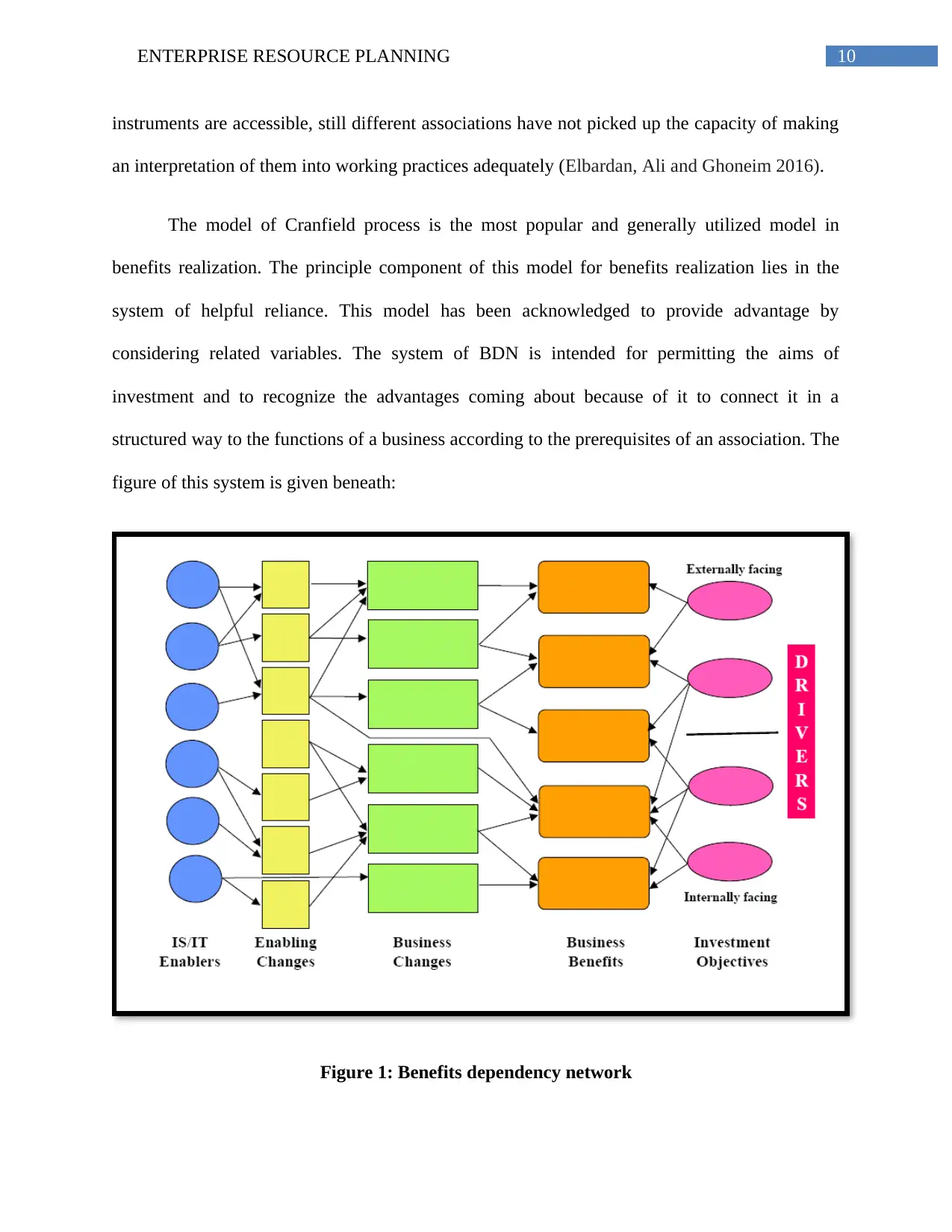
10ENTERPRISE RESOURCE PLANNING
instruments are accessible, still different associations have not picked up the capacity of making
an interpretation of them into working practices adequately (Elbardan, Ali and Ghoneim 2016).
The model of Cranfield process is the most popular and generally utilized model in
benefits realization. The principle component of this model for benefits realization lies in the
system of helpful reliance. This model has been acknowledged to provide advantage by
considering related variables. The system of BDN is intended for permitting the aims of
investment and to recognize the advantages coming about because of it to connect it in a
structured way to the functions of a business according to the prerequisites of an association. The
figure of this system is given beneath:
Figure 1: Benefits dependency network
instruments are accessible, still different associations have not picked up the capacity of making
an interpretation of them into working practices adequately (Elbardan, Ali and Ghoneim 2016).
The model of Cranfield process is the most popular and generally utilized model in
benefits realization. The principle component of this model for benefits realization lies in the
system of helpful reliance. This model has been acknowledged to provide advantage by
considering related variables. The system of BDN is intended for permitting the aims of
investment and to recognize the advantages coming about because of it to connect it in a
structured way to the functions of a business according to the prerequisites of an association. The
figure of this system is given beneath:
Figure 1: Benefits dependency network
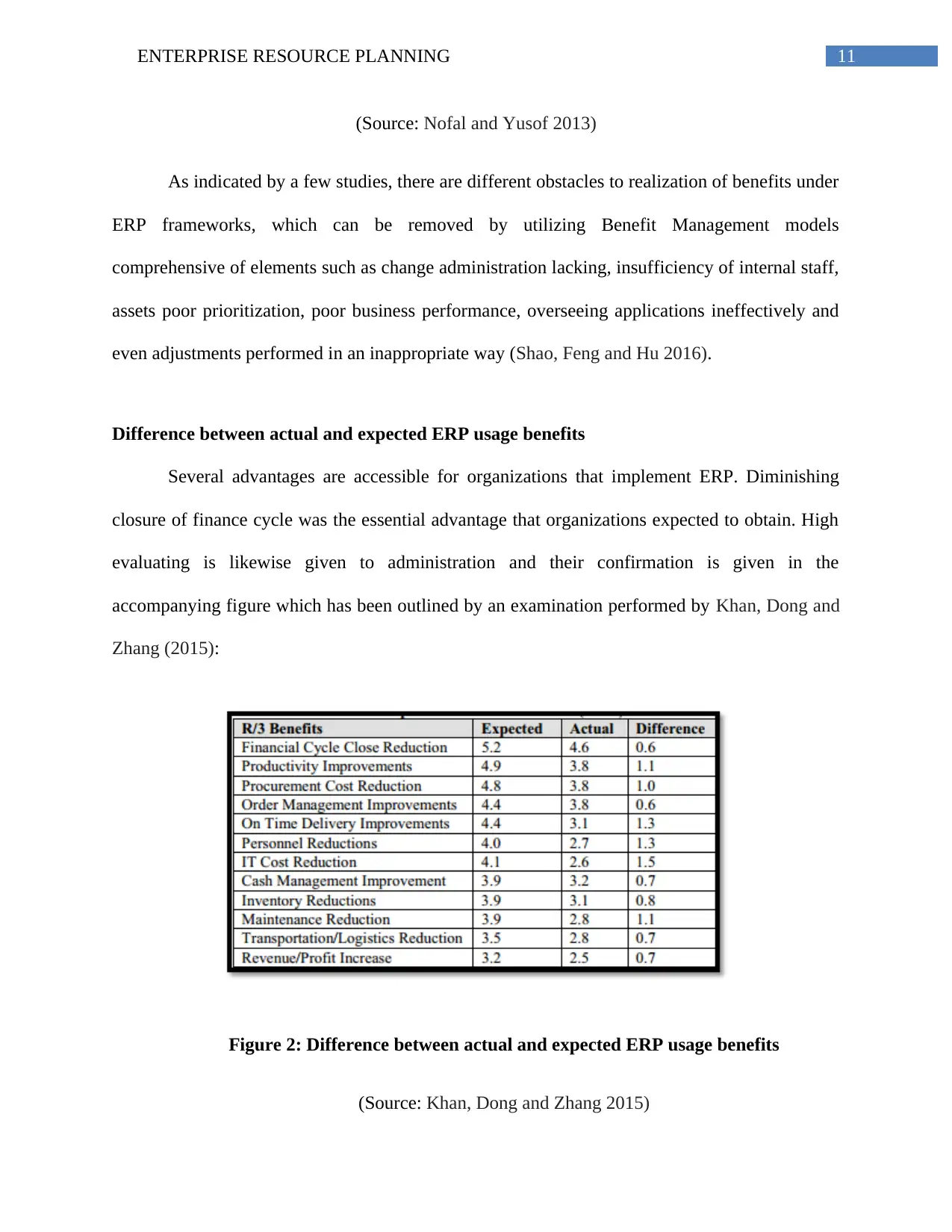
11ENTERPRISE RESOURCE PLANNING
(Source: Nofal and Yusof 2013)
As indicated by a few studies, there are different obstacles to realization of benefits under
ERP frameworks, which can be removed by utilizing Benefit Management models
comprehensive of elements such as change administration lacking, insufficiency of internal staff,
assets poor prioritization, poor business performance, overseeing applications ineffectively and
even adjustments performed in an inappropriate way (Shao, Feng and Hu 2016).
Difference between actual and expected ERP usage benefits
Several advantages are accessible for organizations that implement ERP. Diminishing
closure of finance cycle was the essential advantage that organizations expected to obtain. High
evaluating is likewise given to administration and their confirmation is given in the
accompanying figure which has been outlined by an examination performed by Khan, Dong and
Zhang (2015):
Figure 2: Difference between actual and expected ERP usage benefits
(Source: Khan, Dong and Zhang 2015)
(Source: Nofal and Yusof 2013)
As indicated by a few studies, there are different obstacles to realization of benefits under
ERP frameworks, which can be removed by utilizing Benefit Management models
comprehensive of elements such as change administration lacking, insufficiency of internal staff,
assets poor prioritization, poor business performance, overseeing applications ineffectively and
even adjustments performed in an inappropriate way (Shao, Feng and Hu 2016).
Difference between actual and expected ERP usage benefits
Several advantages are accessible for organizations that implement ERP. Diminishing
closure of finance cycle was the essential advantage that organizations expected to obtain. High
evaluating is likewise given to administration and their confirmation is given in the
accompanying figure which has been outlined by an examination performed by Khan, Dong and
Zhang (2015):
Figure 2: Difference between actual and expected ERP usage benefits
(Source: Khan, Dong and Zhang 2015)
⊘ This is a preview!⊘
Do you want full access?
Subscribe today to unlock all pages.

Trusted by 1+ million students worldwide
1 out of 22
Related Documents
Your All-in-One AI-Powered Toolkit for Academic Success.
+13062052269
info@desklib.com
Available 24*7 on WhatsApp / Email
![[object Object]](/_next/static/media/star-bottom.7253800d.svg)
Unlock your academic potential
Copyright © 2020–2025 A2Z Services. All Rights Reserved. Developed and managed by ZUCOL.




